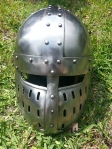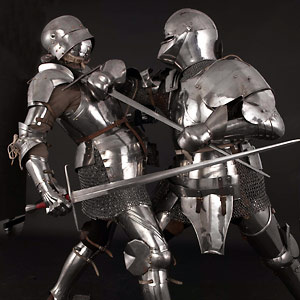By: Jefferson Webb
 Although my great helm served me faithfully for the better part of a decade, I was starting to look around for another helmet to go along with some upgrades to my harness and gear. As I looked around at the various helmets on the market that are mass-produced, I really did not find anything that I thought would be a good replacement. When I looked at custom helmets from some of the outstanding smiths and forges that exist, the price was just much MUCH more than what I was willing to pay. Some of those custom helms are worth it, but I did not want to, nor could I afford to foot that sort of bill. Part of my issue with my great helm I think came from the human desire to change things up sometimes (like redecorating the house, getting a new house or car…). But my research into a new helm also comes from a knowledge that the great helm (in particular this style) was an earlier helmet and as far as we can tell, did not see much use with a harness of plate armour like the bascinet helmets, sallets, and such did. So, the idea that it would be out of place with my harness was lingering there. That said, as a good friend of mine stated in a conversation recently, “The people depicted in most of the sources in harnesses were royalty or nobility, and were able to afford the most up-to-date and complete harnesses. Others such a lower knights and men-at-arms often had to piece together harnesses and this was not so well depicted.” Something that makes perfect sense, and that I already had lingering in the back of my mind as well. Given this conversation and that fact that my great helm has saved my head and face some pain several times over the span of its service to me, I decided to give it an exterior makeover and continue on with this helm. Since it is historically documented that helms were painted from time to time, why not? I decided to share the basic steps with you. Continue reading “Painting Your Helmet”
Although my great helm served me faithfully for the better part of a decade, I was starting to look around for another helmet to go along with some upgrades to my harness and gear. As I looked around at the various helmets on the market that are mass-produced, I really did not find anything that I thought would be a good replacement. When I looked at custom helmets from some of the outstanding smiths and forges that exist, the price was just much MUCH more than what I was willing to pay. Some of those custom helms are worth it, but I did not want to, nor could I afford to foot that sort of bill. Part of my issue with my great helm I think came from the human desire to change things up sometimes (like redecorating the house, getting a new house or car…). But my research into a new helm also comes from a knowledge that the great helm (in particular this style) was an earlier helmet and as far as we can tell, did not see much use with a harness of plate armour like the bascinet helmets, sallets, and such did. So, the idea that it would be out of place with my harness was lingering there. That said, as a good friend of mine stated in a conversation recently, “The people depicted in most of the sources in harnesses were royalty or nobility, and were able to afford the most up-to-date and complete harnesses. Others such a lower knights and men-at-arms often had to piece together harnesses and this was not so well depicted.” Something that makes perfect sense, and that I already had lingering in the back of my mind as well. Given this conversation and that fact that my great helm has saved my head and face some pain several times over the span of its service to me, I decided to give it an exterior makeover and continue on with this helm. Since it is historically documented that helms were painted from time to time, why not? I decided to share the basic steps with you. Continue reading “Painting Your Helmet”



